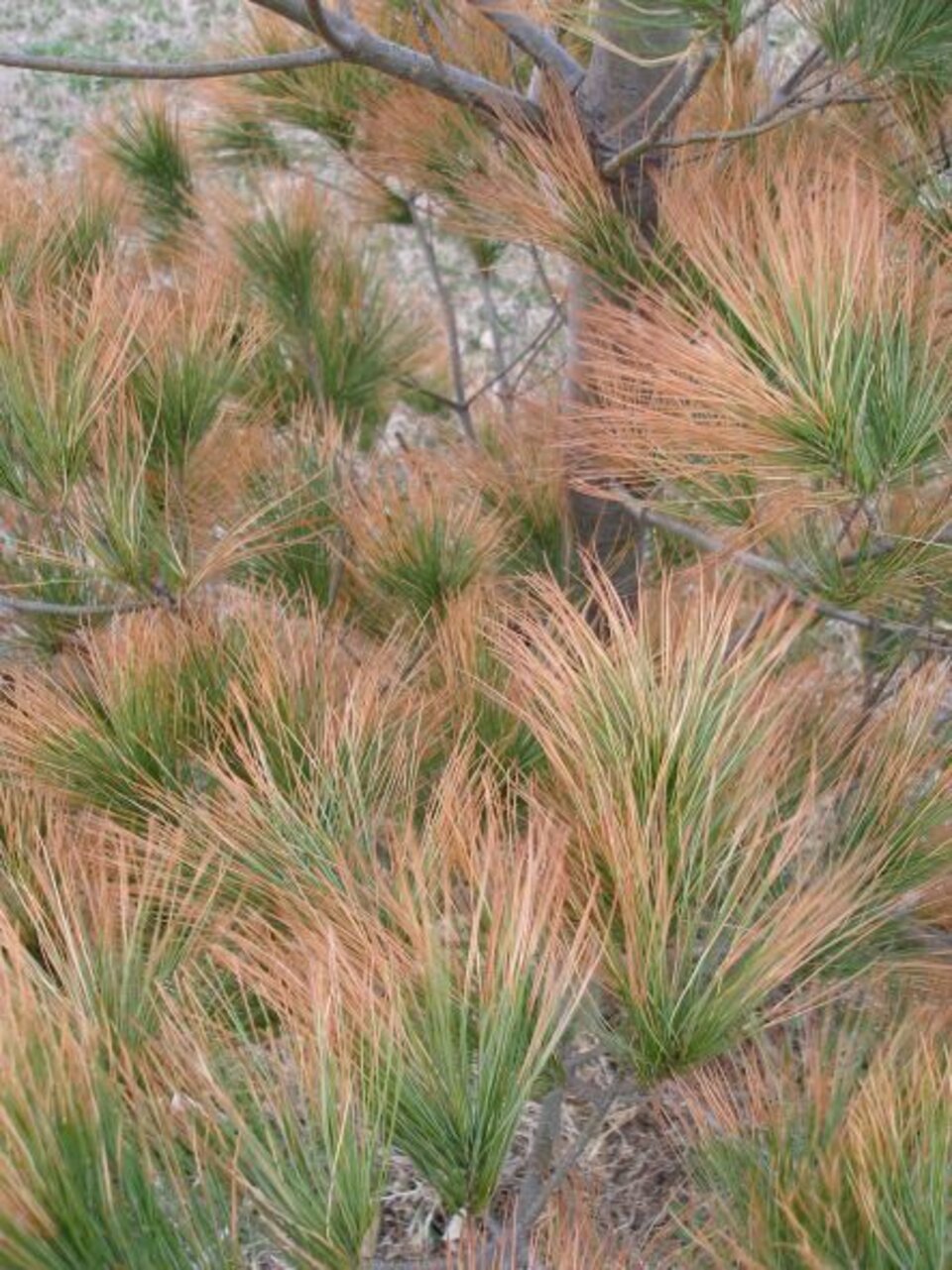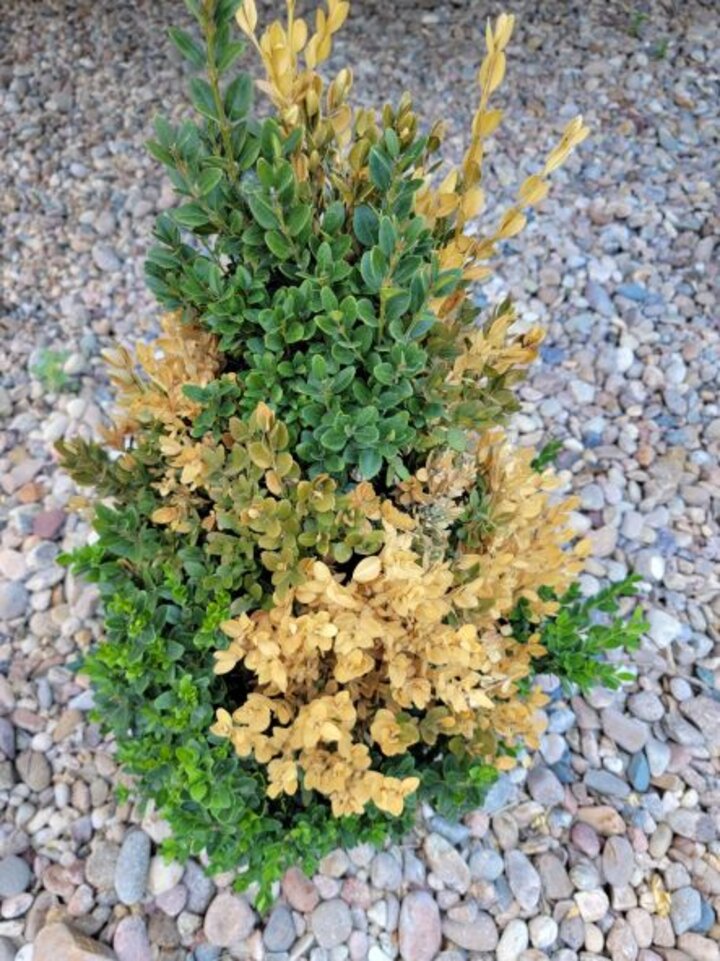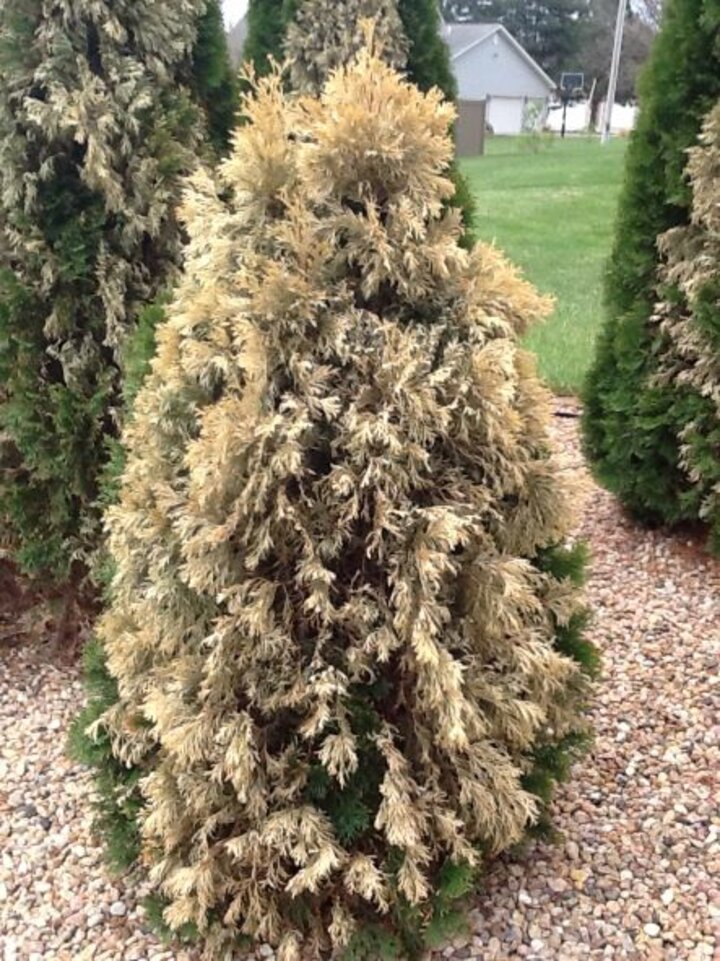Anti-Transpirants Help Prevent Winter Drying Damage

In spring 2021, many gardeners and landscape managers in eastern Nebraska had severe plant damage to boxwood shrubs. In many cases, entire plants were dead. In others, all branches above the protecting snow line were brown, dried and dead. Although boxwood was not the only type of plant showing damage in spring 2021, why was the damage so widespread on this species? The photo above shows winter desiccation of white pine, Pinus strobus, needles. Photo is from Sarah Browning, Nebraska Extension.
Boxwood is a broadleaf evergreen – it’s not a conifer, like pine or spruce - but it does hold its’ leaves all winter. That’s one of the reasons we love it, because it provides green foliage and structure to the winter garden. But holding leaves all winter can be a detriment, too. Boxwoods lose water through natural openings in their leaf surfaces during summer, as do all plants. But they also lose water from their leaves during winter; more water than is lost though the fully dormant stems of deciduous shrubs. This means they need more water in winter than a deciduous shrub to stay healthy. If they cannot pull up enough water to keep the leaves alive, either because of dry or frozen soil, they are susceptible to winter burn or desiccation. Other common terms for winter desiccation include winter burn, winter drying or winter scorch.

That’s what we saw in many landscapes this spring, a combination of severe boxwood winter desiccation and cold temperature injury.
Winter Desiccation Injury
To recap, winter desiccation occurs when the amount of water lost by a plant through its' leaves and stems exceeds the amount available to the roots. Warm, sunny winter days increase the amount of water loss. So does wind - air moving across leaf surfaces pulls moisture out of the leaves. If the soil is frozen or is low in moisture due to dry fall conditions - such as we are experiencing this year - roots are unable to pick up enough water to meet the plant’s need.
Leaves, needles or twigs dry out and die. Leaves or needles may be scorched around the edges or turn completely brown. Evergreen needles may hold their green color until warmer temperatures arrive in spring, thus delaying the appearance of browning symptoms. Sometimes the pattern of damage is directional, on one side of the tree more than the other. Wind accompanying dry periods can accelerate water loss from the plant and result in more extensive damage on the side of the tree facing the prevailing wind. Injury can also be more severe on the side of the plant facing a source of radiated heat, such as a south or west-facing brick wall or street.
Plants particularly susceptible to winter desiccation include boxwood and two additional commonly-planted broadleaf evergreens, holly and mahonia, as well as evergreens like arborvitae and white pine.

Fall and early winter watering, until the soil freezes, certainly helps prevent winter desiccation, but use of an anti-transpirant product can also help protect plants, especially broadleaf or conifer evergreens planted in fall under dry conditions.
Anti-transpirants
The most commonly available product for home gardeners is Wilt-Pruf®, a natural pine oil polymer that forms a clear, flexible coating on plant leaves and stems. It slows the rate of water loss, but does not interfere with normal plant respiration or photosynthesis. The coating gradually weathers and degrades after application. Use the winter application rate and wait to make the first fall application AFTER plants have hardened off and become dormant, usually late November or early December. You’ll need at least 3 to 4 hours of drying time, with air temperatures above freezing to make an application. Spray plants thoroughly, covering both upper and lower leaf surfaces to the point of runoff. When the application is complete, clean the sprayer thoroughly according to label directions to prevent product residues from gumming up nozzle tips and other sprayer components.
Additional anti-transpirant products include Transfilm®and Vapor Gard®. " Vapor Guard should not be used on arborvitae, juniper or cedar. Refer to the label for a full set of restrictions.
The oil base of these products removes the waxy coating in Colorado Blue Spruce that gives its needles their characteristic blue color, changing plants to green. But new growth will emerge with the blue coloration.
Read and follow all label directions carefully, particularly the re-application recommendations, to avoid plant damage and maintain the product's effectiveness throughout the winter.
Note On Terminology
Gardeners may hear two common terms used in relation to these products, either anti-desiccant or anti-transpirant. Technically, an anti-desiccant prevents desiccation or drying of plant tissues. An anti-transpirant limits transpiration, a natural plant process in which water is released from natural openings in the leaf surfaces. Often the terms are used interchangeably, which can be confusing. But just remember, that if you can limit or minimize transpiration (anti-transpirant), you can prevent winter drying (desiccation).
This article was reviewed by Nicole Stoner